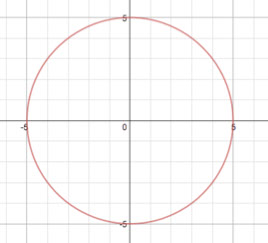Home
Episode 1 Supports
Episode Description
Making Sense: Keoni and Sasha make sense of the new situation in which the x-value is given and y the y-value needs to be determined (instead of the other way around).
Students’ Conceptual Challenges
Students may find it difficult to represent the distance from a point on the parabola to the directrix because the y-value is unknown.
- After struggling with how to represent the unknown value of y and distances involving y [see 1:29 – 2:05], Sasha and Keoni abandon their approach and instead use the equation that they developed in Lesson 2, which is
b = √(4y). [see 2:06].
- After struggling with how to represent the unknown value of y and distances involving y [see 1:29 – 2:05], Sasha and Keoni abandon their approach and instead use the equation that they developed in Lesson 2, which is
Focus Questions
For use in a classroom, pause the video and ask these questions:
1. [Pause video at 0:58]. Sasha drew a vertical line from the x-axis up to the point on the parabola and then extended the line. How will that line segment be useful for their work?
2. [Pause video at 1:54]. Keoni said that the length one side of the right triangle is y – 1. Where is the distance represented by y? by By 1? By y – 1?
Supporting Dialogue
Engage your students in a discussion of the video:
- Ask different students to share how the problem posed in this episode is alike and different from the problems from Lesson 3.
- When one student responds to Focus Question 2, ask 2-3 two or three other students to restate the first student’s idea.
- Ask different students to share how the problem posed in this episode is alike and different from the problems from Lesson 3.
Math Extensions
Consider the circle below.
1. Find the y-value of points on the circle for x-values of 3, 4, and 2.
2. Find an equation for the y-value of a point on the circle for a general x-value.

Mathematics in this Lesson
Lesson Description
Targeted Understanding
CC Math Standards
CC Math Practices
Lesson Description
Sasha and Keoni use the definition of a parabola, the Pythagorean theorem, and their methods from previous lessons to represent the y-value for any point on a particular parabola, given the x-value of that point. In contrast to Lesson 3 in which y-values were given, in this episode x-values will be given.
Targeted Understandings
This lesson can help students:
- Interpret the algebraic expressions that are substituted into the Pythagorean theorem (namely, y – 1, y + 1, and x), during the process of deriving an equation for a particular parabola, as distances on a coordinate grid.
- Conceive of algebraic expressions, such as y – 1, as both a single entity and as a process of subtracting 1 from a number.
Common Core Math Standards
• CCSS.M.HSF.IF.C.8: Write a function defined by an expression in different but equivalent forms to reveal and explain different properties of the function.
Keoni and Sasha re-express the equation for a given parabola that they derived in Lesson 3 (namely, x = √(4y)) as y = x2/4. They discuss how the first form of the equation is easier to use when one is given a y-value and needs to determine the corresponding x-value, while the second form is easier to use when one is given an x-value. However, they recognize that the two forms are equivalent and that either can be used to solve both problems.
• CCSS.M.HSG.GPE.A.2. Define appropriate quantities for the purpose of descriptive modeling.
Sasha and Keoni use the geometric definition of a parabola, along with the Pythagorean theorem to derive the equation of a given parabola (namely, y = x2/4).
• CCSS.M.HSN.Q.A.2: Define appropriate quantities for the purpose of descriptive modeling.
As they work to derive the equation of a given parabola using the Pythagorean Theorem, Sasha and Keoni define three quantities that represent the lengths of the sides of a right triangle. Because they are using a general point (x,y) on the parabola (rather than a specific point), these distances are algebraic expressions: y–1, y+1, and x.
Common Core Math Practices
CCSS.Math.Practice.MP8. Look for and express regularity in repeated reasoning.
In this lesson, re-expressing the equation for a particular parabola, x = √(4y), as y = x2/4x, is not addressed simply as the application of algebraic manipulation skills. Rather, the process of re-expression illustrates the math practice of looking for and expressing regularity in repeated reasoning. In Episode 3, Sasha and Keoni use the equation x = √(4y) (which they derived in Lesson 3), to find the y-value for a point on the parabola when x = 5. They then repeat their reasoning for x = 10 and x = 437. By paying attention to the algebraic transformations they perform each time to isolate and solve for the y-value, they notice regularities which help them generalize their approach to solve x = √(4y) for y in Episode 4. Approaching the act of re-expression as the generalization of repeated reasoning carries the benefit of reinforcing the equivalence of different forms of an equation and can help students deal with an abstract situation with more meaning.

















